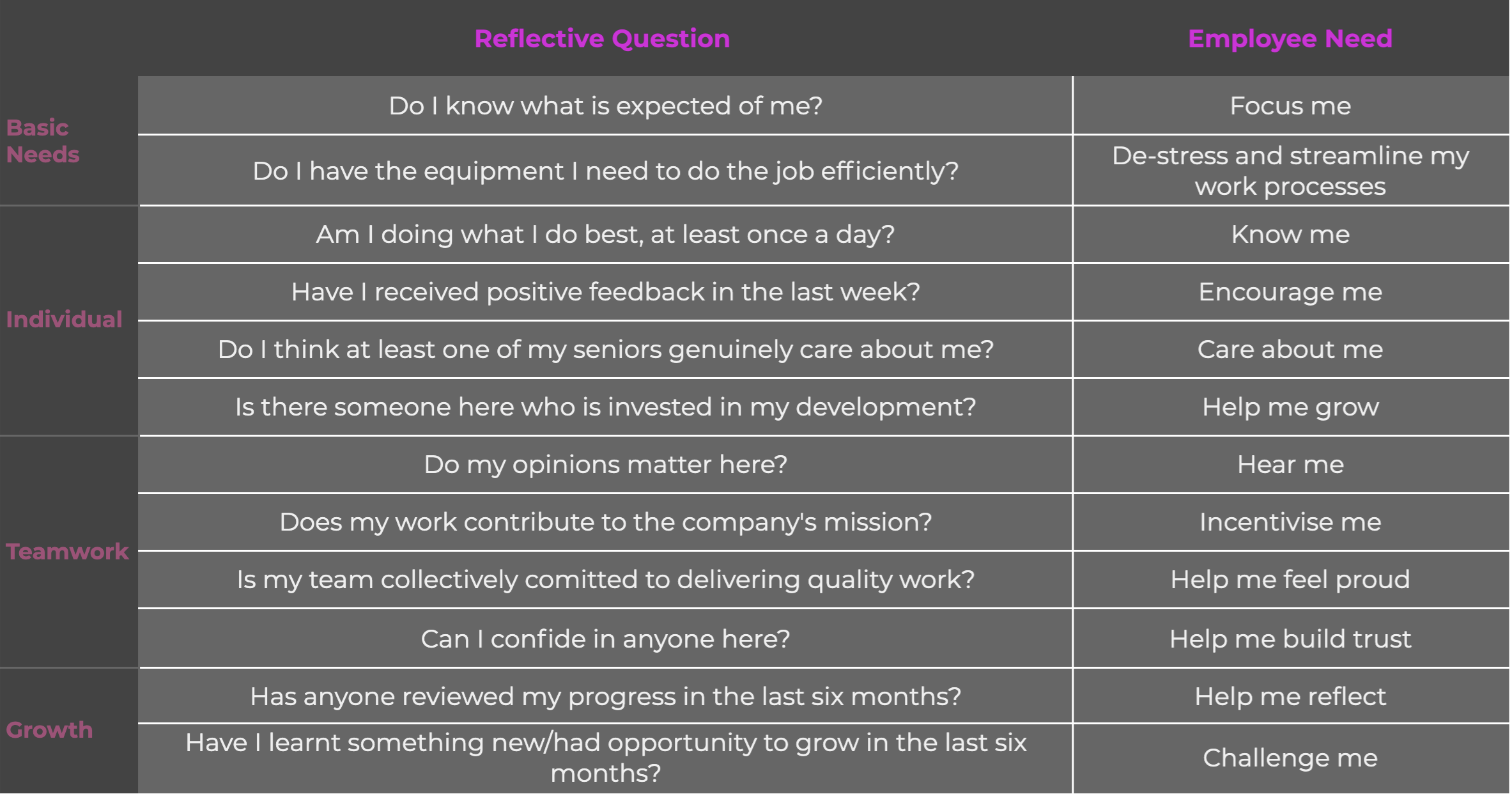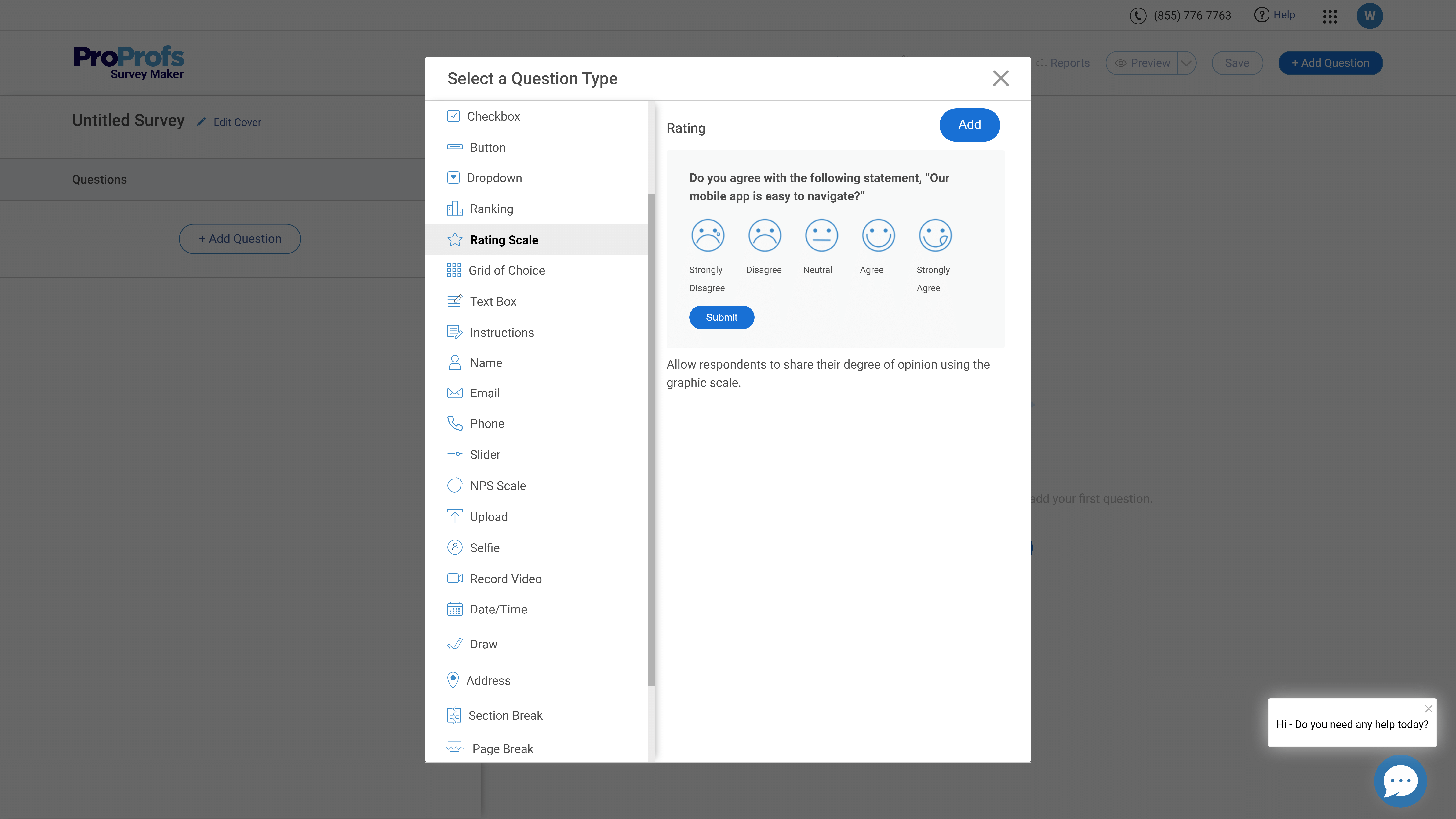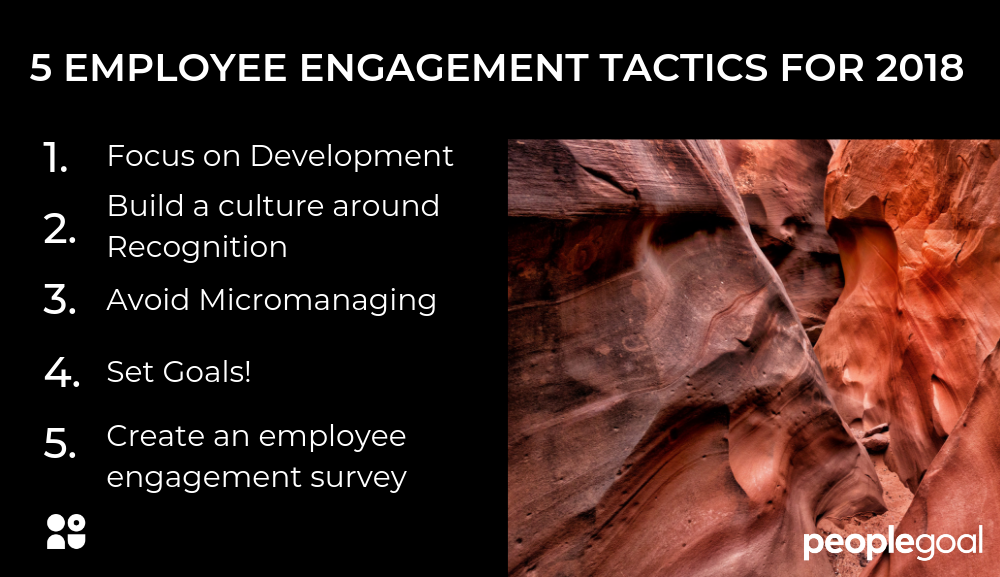Strong teams don’t happen by accident.
They’re built on clear expectations, continuous learning—and conversations that matter.
In my work designing feedback systems across organizations, one pattern stands out:
“Meaningful feedback isn’t about more questions, it’s about better ones. It’s about creating a space where employees feel safe, heard, and motivated to grow.”
An employee feedback survey, when done right, becomes more than a data point. It becomes a bridge—connecting everyday experiences to improved performance.
This guide is about helping you build that bridge. You’ll learn:
- How to structure surveys that invite honest employee feedback
- How to uncover insights that employees tend to otherwise hide
- How to lead to real change (3x performance boost)
Because when you listen with purpose, you don’t just gather feedback—you earn trust.
What is an Employee Feedback Survey?
An employee feedback survey is a structured questionnaire used to gather honest insights from employees about their work environment, engagement, and satisfaction.
It helps organizations understand how employees feel about their roles, managers, teams, and workplace culture.
By identifying strengths and areas for improvement, these surveys enable companies to boost morale, improve communication, and drive long-term employee success.
Well-designed feedback surveys are key to creating a thriving, motivated workforce—and ensuring every voice is heard.
Why Use One?
Because your team wants to be heard—and you want to lead better. Here’s what a feedback survey helps you do:
- Boost engagement by showing employees their voice matters
- Build accountability across individuals and teams
- Get visibility into performance, skills, and culture dynamics—especially in remote or hybrid setups
How to Design an Employee Feedback Survey That Builds Trust
Creating a customized feedback survey sounds complex—but with the right tool, it’s surprisingly simple.
Here’s how you can set up a professional employee survey using PeopleGoal’s 360° Feedback app—no coding, no headaches.
Step 1: Pick a Ready-to-Use Template
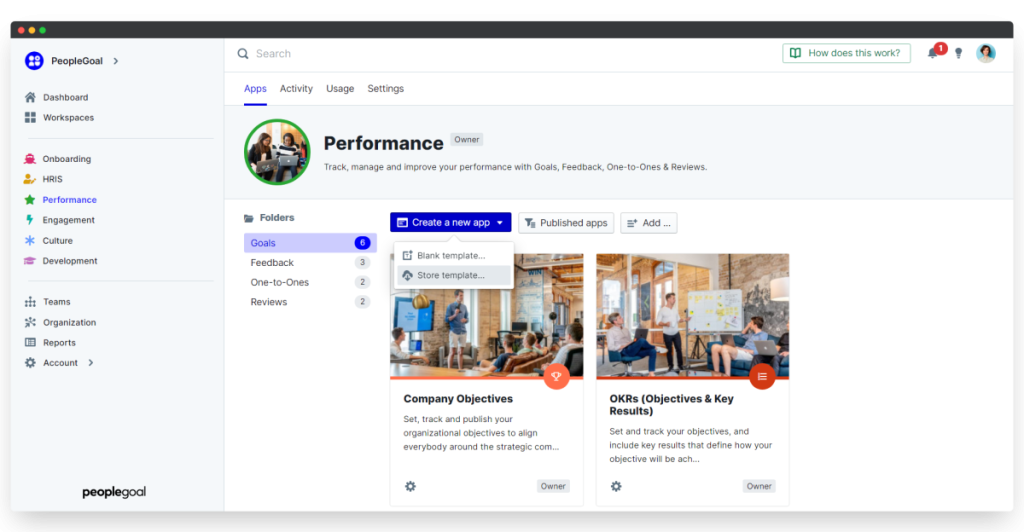
Log in to PeopleGoal and open the App Store.
Search for the 360° Feedback template.
This prebuilt version comes loaded with common feedback sections like peer reviews, competencies, and open comments—saving you hours of setup time.
Pro Tip: You can launch the survey as-is or tweak it later to fit your company’s style.
Step 2: Customize Your Questions
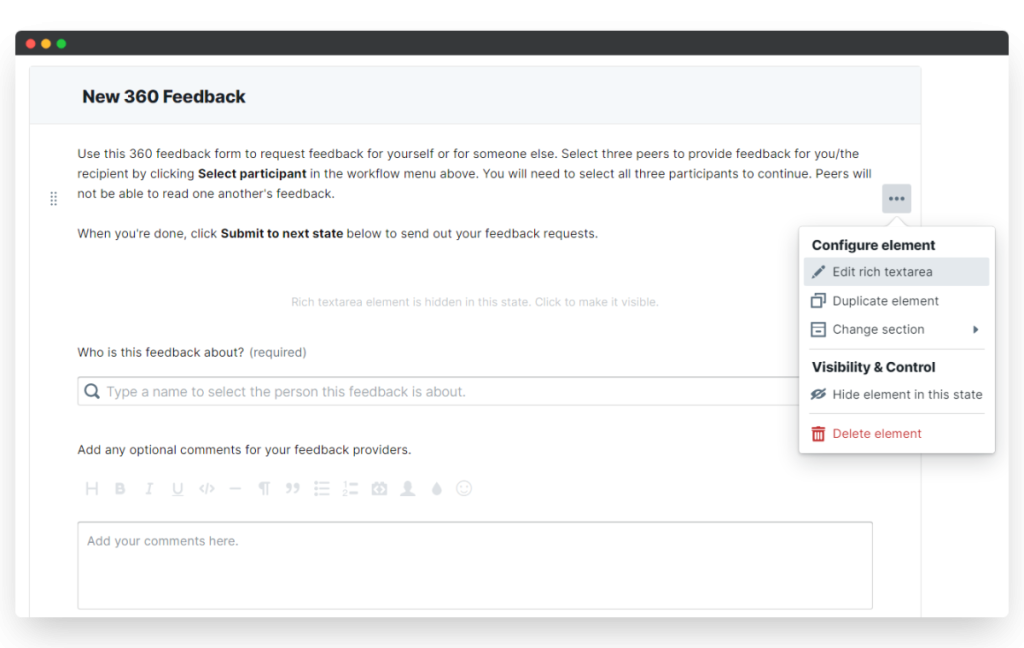
Click into the survey editor to start shaping the survey for your team:
- Edit or rearrange questions to match your goals.
- Add new elements like rating scales (“Strongly Agree–Strongly Disagree”) or open comment fields.
- Group questions by audience—managers, peers, or direct reports—for more relevant feedback.
Example:
Want to ask managers about leadership skills, but peers about teamwork? You can easily separate those.
Step 3: Map the Survey Workflow (Don’t Worry—It’s Visual)
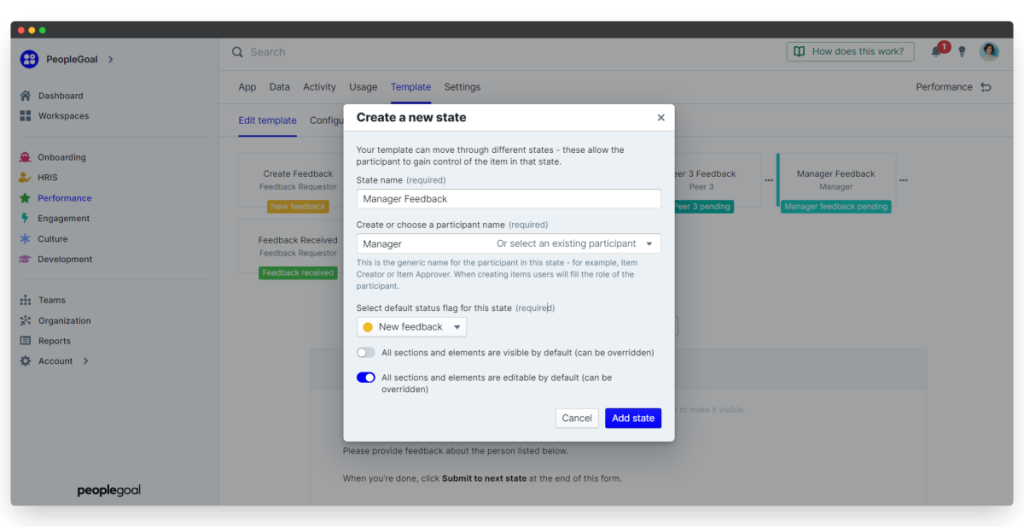
In PeopleGoal, every survey flows through simple states (think of them as steps in the process):
- Employee submits a request
- Peers and managers respond
- A summary report is created
You can drag and drop these steps, add notifications, and control who sees what—keeping feedback private and fair.
Pro Tip: Want manager feedback to stay private, but peer feedback to be visible? You can set that with a few clicks.
Step 4: Add Participants and Set Privacy Rules
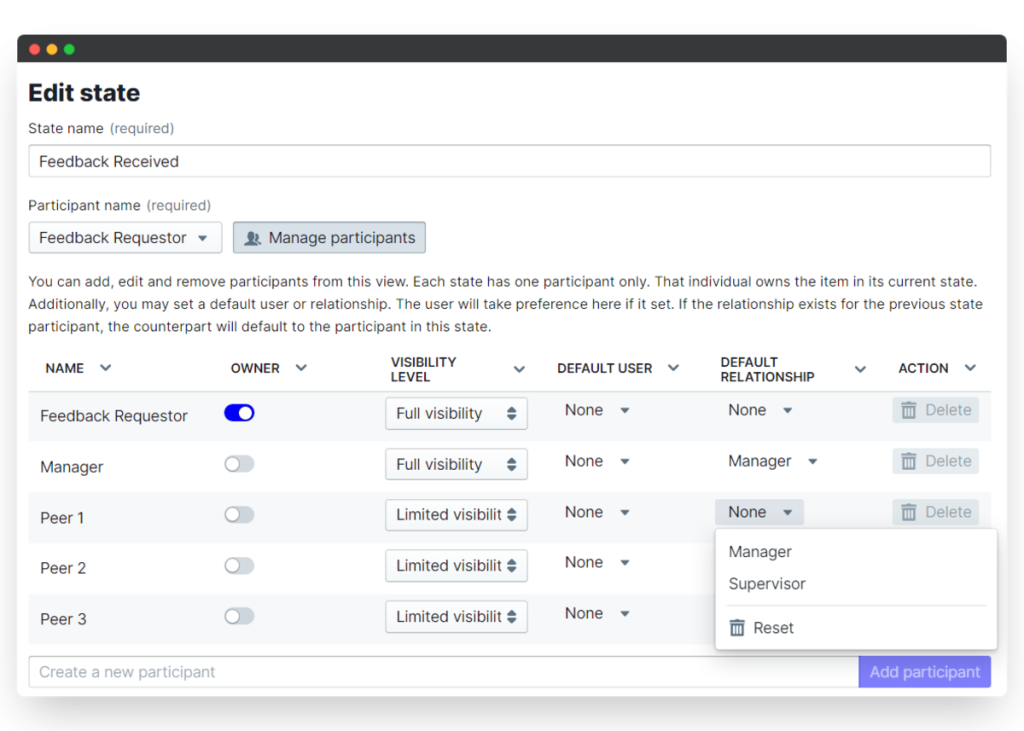
Decide who should give feedback—and who will receive it.
PeopleGoal lets you:
- Invite specific managers, peers, or self-reviewers
- Control visibility settings (anonymous or open)
- Limit access to just the right people at every step
Pro Tip: For sensitive feedback, use anonymous links to boost honesty.
Step 5: Launch Your Survey
Once your survey is ready:
- Hit Launch to send it to individuals or teams.
- Set up automated reminders to nudge participants.
- Use the built-in dashboard to track responses in real time.
Need a Step-by-Step Walkthrough? Check out this guide:
The 3 Core Types of Feedback (to Keep in Mind)
To design a solid survey, it helps to know the three main types of feedback you’ll be collecting:
- Evaluation – This is your benchmark. It answers “Where are they right now?”
- Appreciation – Everyone needs a win. Positive feedback motivates and reinforces good work.
- Coaching – Forward-focused. Helps employees grow with clear, constructive input.
Want to see how employee feedback connects directly to customer success? Check out our guide on How to Improve Customer Experience Using Employee Feedback.
Why Most Employee Feedback Surveys Fail (and How Yours Won’t)
Even the best intentions can backfire if your survey process isn’t thoughtful. Here are five common mistakes companies make when running employee feedback surveys—and what you can do differently:
1. Asking for Feedback, Then Ignoring It
The biggest red flag? No follow-up.
If you collect feedback but never share results or take action, employees stop believing in the process. It feels like their input vanishes into a void.
“We had a survey last year. Nothing changed. No update, no plan. I don’t even know why they bother.” — Reddit user, r/humanresources
How to Fix it: Share the results (even the hard ones), highlight 1–2 key actions you’re taking, and report back regularly.
Thinking about using 360 feedback in your survey process?
Don’t miss these Top 10 Challenges with 360 Feedback to avoid common mistakes and set it up for success.
2. Designing Vague or Biased Questions
Questions that are unclear, overly broad, or push a specific narrative can confuse or frustrate employees. Worse, they yield bad data.
Fix it: Ask clear, specific, and actionable questions. Avoid double-barreled prompts like “Do you feel supported and challenged?”
3. Promising Anonymity—But Not Really Delivering
If surveys are linked to employee IDs or ask for detailed demographics in small teams, people will assume you’re tracking them.
“They called it anonymous, but I had to log in to complete it. I gave all 3s just to stay neutral.” — Reddit user, r/LifeProTips
Fix it: Use third-party tools or anonymous links, avoid identifying questions, and clearly explain how anonymity is protected.
4. Survey Fatigue
If you’re constantly pinging employees with long or repetitive surveys, they’ll tune out—or rush through without thinking.
“We get these ‘pulse checks’ like every other week now. It’s just noise at this point.” — Reddit user, r/humanresources
Fix it: Keep surveys short (5–10 questions max) and purposeful. Space them out and rotate topics to avoid repetition.
Want to dig deeper into what causes survey fatigue—and how to prevent it?
Read our full guide: What is Survey Fatigue & How to Avoid It
5. Creating the Illusion of Listening
Some companies use surveys to appear engaged without actually wanting feedback. Employees see through this.
Fix it: Be transparent about your intent. If you’re not ready to act on feedback, hold off on the survey until you are.
Before jumping in—surveys work best when designed around clear goals and employee context. These five formats will help you get focused, meaningful insights that actually drive performance.
5 Powerful Employee Feedback Survey Formats (and When to Use Them)
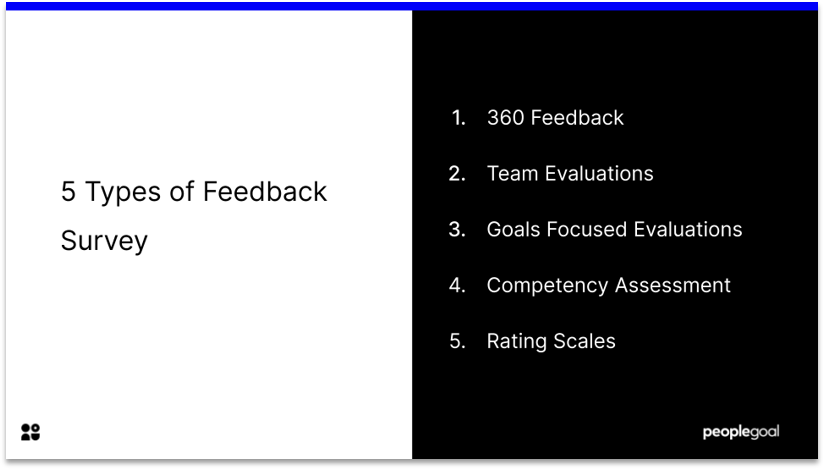
1. 360-Degree Feedback Survey
If you’re trying to identify top performers or future leaders, this one’s for you.
360-degree feedback gathers input from managers, peers, direct reports, and even cross-functional teams. It removes the top-down bias of traditional reviews and gives you a fuller picture of how someone performs across collaboration, leadership, and communication.
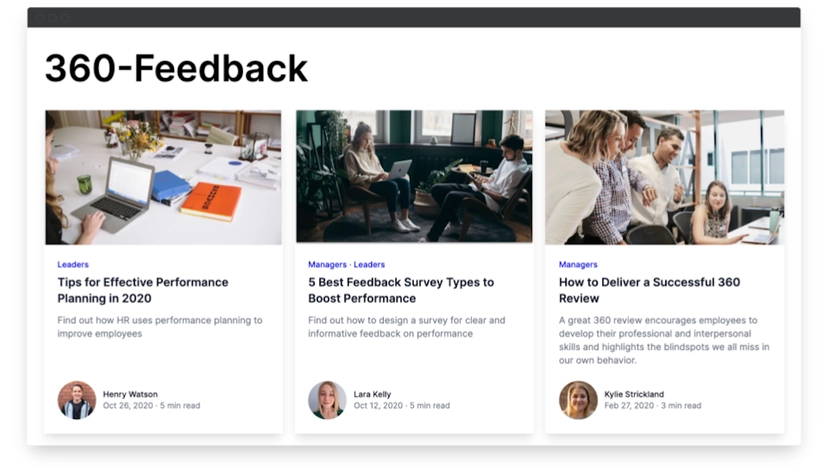
When to use it:
- Developing leadership pipelines
- Reviewing mid-to-senior-level employees
- Supporting career growth discussions
Make an informed call with this breakdown of the pros and cons of 360 performance reviews.
Why it works:
- Holistic view of performance
- Boosts accountability and self-awareness
- Especially effective in remote work/hybrid setups where visibility is limited
Want to see how 360° feedback looks in action?
Check out these 35+ Employee 360-Degree Feedback Examples (With Best Practices) to get inspired with real-world templates and tips.
2. Team Evaluation Survey
Individual performance matters—but high-performing teams are what drive business results.
Team evaluation surveys assess how well groups collaborate, communicate, and deliver on shared goals. They’re perfect for recognizing unsung team dynamics that contribute to success.
When to use it:
- End-of-project retrospectives
- Cross-functional team reviews
- Morale checks for remote or hybrid teams
What to assess:
- Communication and coordination
- Conflict resolution
- Shared ownership of outcomes
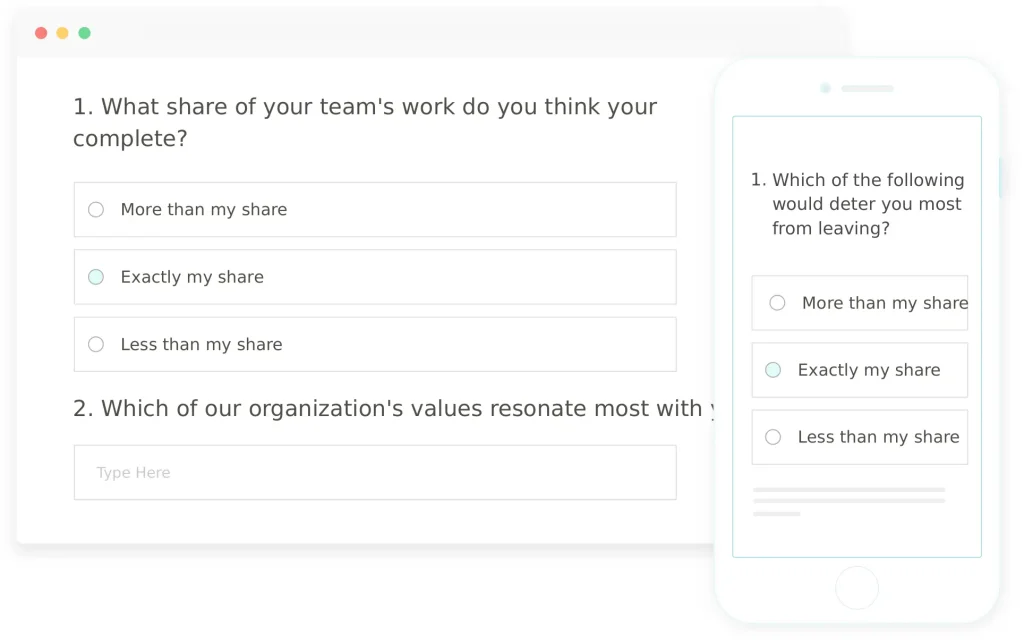
3. Goal-Focused Evaluation
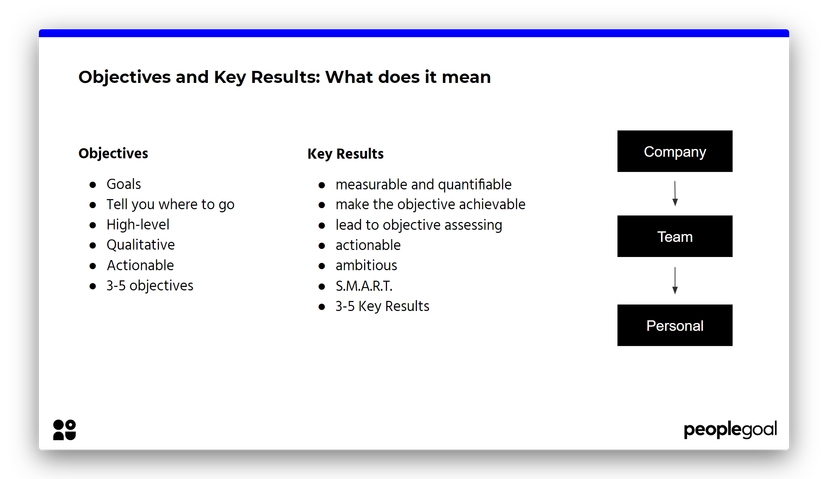
If you’re already using OKRs or SMART goals, this format ties feedback directly to those metrics.
Instead of broad or generic evaluations, goal-focused surveys ask how well an employee is progressing toward clearly defined targets—making the feedback feel fair and actionable.
Reviewing tasks set can be a great way to evaluate employee performance in a more tangible way. DIY Committee Guide highlights that “Evaluation is an assessment or judgement made by comparing what actually happened with what was intended”. By looking at an individual’s projects, you measure goals against results.
When to use it:
- Quarterly or biannual check-ins
- Performance improvement plans
- New hire 90-day reviews
✅ Pro insight: Pair this with 360 or manager reviews to reduce subjectivity and increase clarity.
4. Competency Assessment
According to Cheryl Lasse at The Association for Talent Development, competency measures ‘how (behaviors) somebody does the what (task or skill). Competency assessments are crucial for highlighting skills gaps in a company.
This format zeroes in on how work gets done—not just what gets done.
Competency assessments evaluate behaviors like collaboration, adaptability, leadership, and initiative. It’s a great tool for spotting skill gaps and designing personalized development plans.
When to use it:
- Career progression and promotion cycles
- Building training or reskilling programs
- Performance diagnostics
What to include:
- Self-assessment questions
- Behavioral scoring (e.g., “rarely demonstrates” to “always demonstrates”)
- Manager/mentor observations
5. Rating Scale (Likert) Surveys
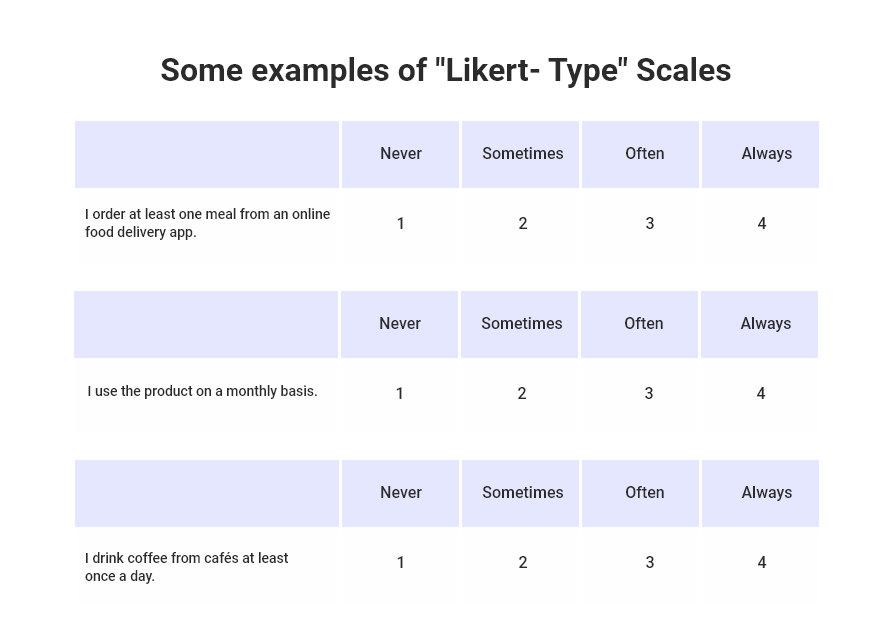
Looking for a simple, scalable format? Likert scale surveys help you measure perceptions and trends at a glance.
These surveys use a 5–7 point scale (e.g., strongly disagree to strongly agree) and are ideal for quick sentiment checks, tracking progress, and building benchmarks over time.
When to use it:
- Monthly or quarterly pulse checks
- Culture and engagement reviews
- Supplementing qualitative feedback
Sample employee feedback survey questions:
Here are a few questions on Likert scales that HR might consider for feedback surveys:
- ‘This individual works effectively with their teammates’ (Rank from Never to Always)
- ‘I expect this employee to complete tasks in a timely manner’ (Rank from Highly Unlikely to Very Likely)
- ‘This employee has shown progress in the past 6 months’ (Rank from Strongly Disagree to Strongly Agree)
Rating scales help you provide valuable feedback to your teams.
Real-World Employee Feedback Questions That Actually Get Answers
Not sure what to ask in your survey? Here are real, easy-to-use questions across five key areas that affect employee performance and morale. Each one is designed to give you clear, honest answers you can actually use.
These employee feedback survey examples cover what matters most to your team:
Work Satisfaction
How happy are employees with their work and daily responsibilities?
- How satisfied are you with your current role?
- Is there anything we could change to make your day-to-day work better?
Recognition
Do employees feel appreciated for what they do?
- Do you feel recognized for your efforts at work?
- When was the last time someone thanked you or praised your work?
Manager Effectiveness
Is the manager supportive and clear in communication?
- Does your manager clearly explain what’s expected of you?
- Can you openly share feedback or concerns with your manager?
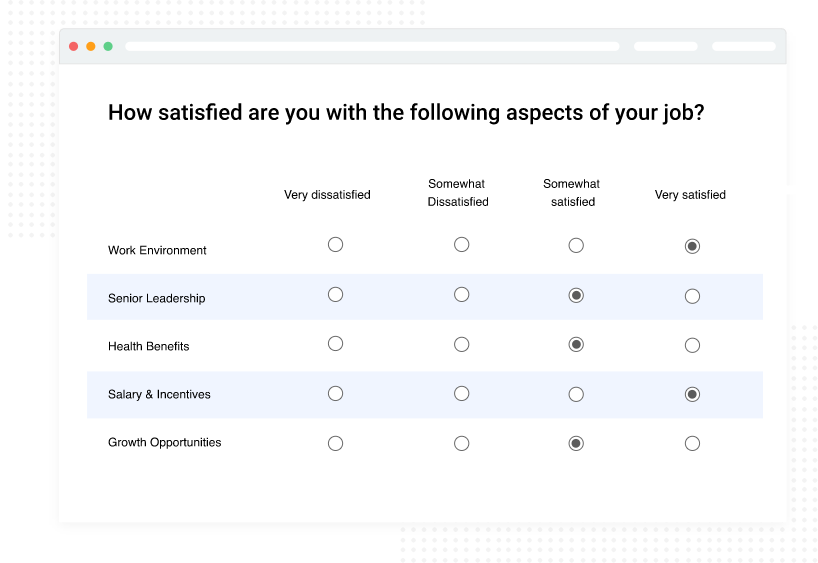
- Peer Collaboration
How well do team members work and support each other?
- Do you feel your teammates are easy to work with?
- If you need help, can you count on your colleagues?
Growth and Learning
Are employees learning and moving forward in their careers?
- Do you feel you’re learning new skills in your current role?
- What’s one skill you’d like to develop in the next few months?
Keep your questions simple, direct, and relevant—and you’ll get feedback that’s actually helpful.
5 Essential Rules to Make Your Employee Feedback Survey Work
You’ve got your survey ready. Now, how do you make sure it actually helps your team and doesn’t just feel like another HR formality?
Here are 5 simple (but powerful) best practices to make sure your feedback survey actually works—and earns your team’s trust:
1. Be Clear About the Why
Tell your team exactly why you’re running the survey and how their responses will be used.
When people know the purpose, they’re more likely to answer honestly—and actually care.
Try this: “We’re doing this to improve how we support you—not just to tick a box.”
2. Keep It Short and Relevant
Nobody wants to fill out a 40-question form after a long workday. Aim for 5–20 questions that get straight to the point.
Focus on real, actionable areas like recognition, workload, or team dynamics. If a question doesn’t lead to a potential action, cut it.
3. Make It Feel Safe to Answer
Trust is everything. If people think their answers aren’t really anonymous, they’ll either hold back—or not answer at all.
Use a third-party tool or an anonymous form (like Google Forms with no email tracking). And say upfront: “We won’t collect names, emails, or any data that can identify you.”
4. Mix Ratings with Open Questions
Use a combo of rating scales (1–5) and open-ended questions.
This gives you quick data for trends—and space for employees to share context or explain their scores.
Example:
Rate: “How supported do you feel by your manager?”
Open follow-up: “What’s one thing they could do better?”
This balanced format makes your feedback survey questions feel personal and flexible.
5. Share the Results—Then Act
One of the biggest mistakes? Collecting feedback and doing nothing with it.
Always tell your team what you heard and what you’re doing about it.
Try this:
“You told us recognition needs work. So we’re starting a monthly ‘shout-out’ session in team meetings.”
Even small changes show that feedback drives action—and that builds long-term trust.
Not all feedback will be easy to hear—but it’s often the most valuable.
Here are 10 practical steps to deal with negative feedback the right way.
Turning Feedback Into Real Change: Your Next Steps
Employee feedback surveys are more than a formality—they’re a strategic tool to drive clarity, accountability, and growth across teams.
To make them effective:
- Choose the right survey type based on your goals—whether it’s 360 feedback, team evaluations, or goal tracking
- Ask targeted, easy-to-understand questions that invite honest responses
- Keep surveys short, anonymous, and relevant to everyday work
- Most importantly, follow up on the results—because listening without action builds distrust
If you’re looking to implement surveys that are easy to manage, customizable, and insightful, performance management tools like PeopleGoal can help you streamline the process while keeping it flexible to your culture and workflow.
What You Can Do Next:
- Start small: run a short survey focused on one priority area
- Use a blend of rating and open-ended feedback survey questions
- Schedule regular feedback cycles, not just annual reviews
- Share results transparently, and act on them where it counts
Want to move beyond one-off surveys? Learn how to build a rhythm of feedback that drives real improvement—read our guide on Why You Need a Continuous Feedback Process More than Ever.
Employee Feedback Survey FAQs: Everything You Need to Know Before You Start
Why are employee feedback surveys important?
They provide a structured method for employees to voice their opinions, leading to increased engagement, improved morale, and actionable data for organizational growth.
How often should we conduct employee feedback surveys?
The frequency depends on organizational needs. Some companies opt for annual comprehensive surveys, while others implement shorter "pulse" surveys quarterly or even monthly to monitor ongoing sentiments.
What types of questions are included in employee feedback surveys?
Questions typically cover areas such as job satisfaction, management effectiveness, communication, work environment, and opportunities for professional development.
Can feedback surveys improve employee retention?
Yes, when employees feel heard and see tangible changes resulting from their feedback, it fosters trust and can lead to higher retention rates.
Ready to 3x Your Teams' Performance?
Use the best performance management software to align goals, track progress, and boost employee engagement.

